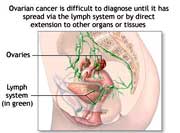|
| |
New tool for early detection
of ovarian cancer
Main
Article page | Health page|
Fitness articles|
Diseases

Washington, (ANI):
CA-125, the protein long-recognized for predicting
ovarian cancer recurrence, has now emerged as a
promising tool for early-stage disease, found
researchers at The University of Texas MD Anderson
Cancer Center.
Dr. Karen
Lu, said that if a larger study shows survival benefit,
the simple blood test could offer a much-needed
screening tool to detect ovarian cancer in it early
stages - even in the most aggressive forms - in
post-menopausal women at average risk for the disease.
"Over the
last ten years, there's been a lot of excitement over
new markers and technologies in ovarian cancer. I and
other scientists in the gynaecologic oncology community
thought we would ultimately find a better marker than
CA-125 for the early detection of the disease. After
looking at new markers and testing them head-to-head in
strong, scientific studies, we found no marker better
than CA125," said Lu.
For Lu, the
challenge is that more than 70 percent of women with
ovarian cancer are diagnosed with advanced disease.
"Finding a
screening mechanism would be the Holy Grail in the fight
against ovarian cancer, because when caught early it is
not just treatable, but curable," said Lu.
For the
prospective, single-arm study, 3,252 women were enrolled
from seven sites across the US. All were healthy,
post-menopausal women, ages 50-74, with no strong family
history of breast or ovarian cancer.
The study's
primary endpoint was specificity, or few false
positives.
In
addition, the study looked at the positive predictive
value, or the number of operations required to detect a
case of ovarian cancer.
Each woman
received a baseline CA-125 blood-test.
Using the
Risk of Ovarian Cancer Algorithm (ROCA), a mathematical
model based on the patient's age and CA-125 score, women
were stratified to one of three risks groups, with the
respective follow-up: "low," came back in a year for a
follow-up blood test; intermediate," further monitoring
with repeat CA125 blood test in three months; and
"high," referred to receive transvaginal sonography
(TVS) and to see a gynecologic oncologist.
Cumulatively, 85 women (2.6 percent) were determined to
be high risk, and thereby received the TVS and were
referred to a gynecologic oncologist. Of those women,
eight underwent surgery: five were found to have ovarian
cancer, three with invasive and two with borderline
disease; and three had benign tumors - a positive
predictive value of 37.5 percent.
On the
other hand, no more than three operations would be
required to detect each case of ovarian cancer,
explained Lu.
The
screening failed to detect two borderline ovarian
cancers.
Of great
importance, said Lu, is that the three invasive ovarian
cancers detected were high-grade epithelial tumors, the
most aggressive form of the disease, and were caught
early (stage IC or IIB), when the disease is not only
treatable, but most often curable.
Lu also
noted that all three women found to have invasive
disease were monitored at low risk for three years or
more prior to a rising CA-125.
"CA-125 is
shed by only 80 percent of ovarian cancers. At present,
we are planning a second trial that will evaluate a
panel with four blood tests including CA-125 to detect
the cancers we may otherwise miss with CA-125 alone. The
current strategy is not perfect, but it appears to be a
promising first step," explained Bast.
The study
will be presented at the American Society of Clinical
Oncology (ASCO) annual meeting. (ANI)
| |
|



